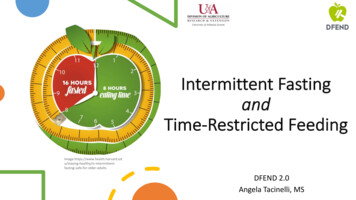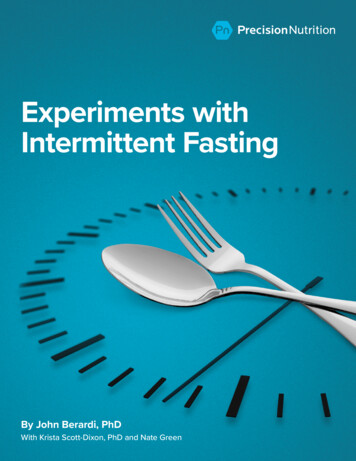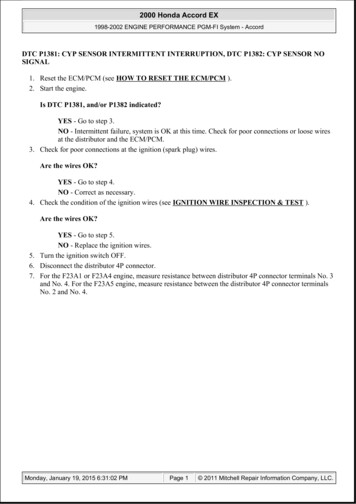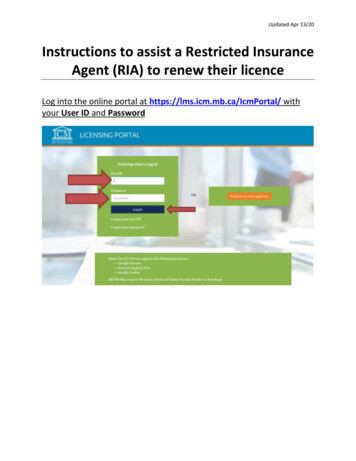
Transcription
Intermittent FastingandTime-Restricted ultsDFEND 2.0Angela Tacinelli, MS
Objectives1. Define intermittent fasting (IF)2. Define time-restricted feeding (TRF)3. Learn about the different forms of IF & TRF4. Understand the benefits, risks, current research with IF & TRF
Defining Intermittent Fasting & Time-Restricted Feeding Intermittent Fasting An eating pattern which includes hours or days of eating minimalto no food without being deprived of essential nutrients. Time-Restricted Feeding/Eating Eating only during certain time period (8 or 10 hours) each day.
Forms of Intermittent Fasting & Time-Restricted FeedingIntermittent Fasting Alternate-day fasting 5:2 fasting (The 5:2 Diet) 24-hour fast (Eat, Stop, Eat) The warrior diet Spontaneous meal skippingTime-Restricted Feeding 16/8 method 14/10 method
wiki/Intermittent fasting#/media/File:IFCalendar.png
Alternate-day FastingFast every other day by either not eating anything or only having asmall meal (less than 500 on/6ways-to-do-intermittent-fasting#section7
The 5:2 Diet (Twice-a-Week Method)Eat normal 5 days of the week while only 500-600calories the other 2 days of the ays-to-do-intermittent-fasting#section7
The 24-Hour Fast (Eat Stop Eat)Fast for a full 24-hours 1-2 days a week and eatnormally on all the other ays-to-do-intermittent-fasting#section7
The Warrior DietEat small amounts of fruits and vegetables during the day &eat one huge meal at night during a 4-hour time 6ways-to-do-intermittent-fasting#section7
Spontaneous Meal SkippingSkip 1-2 meals when you don’t feel hungry or don’t have time to ys-to-do-intermittent-fasting#section7
wikimedia.org/wikipedia/commons/8/89/Intermittent fasting.svg
16/8 MethodDaily 16-hour fasts and eat only 2-3 mealsduring an 8-hour time 6ways-to-do-intermittent-fasting#section7
14/10 MethodDaily 14-hour fasts and eat only 2-3 mealsduring a 10-hour time period.FirstMeal- 10amFirstMeal- 10amFirstMeal- 10amFirstMeal- 10amFirstMeal- 10amFirstMeal- 10amFirstMeal- MealSecondMealSecondMealLast Meal8pmLast Meal8pmLast Meal8pmLast Meal8pmLast Meal8pmLast Meal8pmLast Meal8pmFASTFASTFASTFASTFASTFASTFASTImage Adapted from ntermittent-fasting#section7
What is allowed during the fast Water Black Coffee (NO MILK, CREAM OR SUGAR) Zero-Calorie BeveragesWhat is NOT allowed during the fast Solid or caloric foods & beverages
What foods should you eat? Avoid processed, high-calorie foodsLean nt-fasting-foods-to-eat-and-avoidCheck out the DFEND website for fasts facts on: Foods in a healthy eating pattern How much of each food group is recommended
Are intermittent fasting & time-restricted feedinggood for you ?
The Potential Benefits May help you naturally eat less1 Some studies have found that TRF can help reduce the number of calories you eat However this was not the case across all studies. Some did not observe areduction in calorie consumption. How to avoid this? Avoid high-calorie foods. Weight loss THE KEY: Lower glucose levels when fasting because our body metabolicallyswitches to using energy from fat instead of glucose (blood sugar) 2, 3 Help reduce the risk of obesity-related disease4
The Potential Benefits Improve health conditions5 Obesity, diabetes, cardiovascular disease, cancers, & neurological disorders It may help reduce inflammation and improve disease-relatedconditions associated with inflammation2 Alzheimer’s disease, Arthritis , Asthma, Multiple sclerosis, Stroke
The Possible Risks or Side Effects6HungerFatigueInsomniaNausea (do you have to eat withmedication?) Headaches Concern about losing too muchweight for some individuals Image: reatment/cpap-side-effects/
Current Research Most research uses diet records to lookat the effects of IF or TRF and dietrecords are not always the mostaccurate Most studies have looked at short-termeffects but the long-term health effectsare lesser known Most research has been done inoverweight and middle-aged adults somore research is needed in healthyweight, younger, and older adults7Image: reatment/cpap-side-effects/
Things to keep in mind As with any healthy dietary pattern, the most benefits are gained when they areimplemented as a long-term, or lifestyle, change Pick what works best for you and your schedule! Also consider a gradual, phasedin schedule. It important to make sure that the meals you DO EAT contain healthy fruits &vegetables and are balanced to meet nutritional needs including carbohydrates,fats, proteins, and other micronutrients
Summary1.IF involves full days of completely fasting or limited calorie intake2.TRF is a specific type of IF that involves fasting and eating during set time periods eachday3.Research has showed that IF can have health benefits much like diets that focus oncaloric restriction84.It is important that you are still getting all the necessary nutrients from the food/mealsthat you DO EAT when not fasting5.Pick what works best for you AFTER speaking with a licensed dietician or physician!If you can’t stick to it long-term, it may cause more harm than good.
Next week Carbohydrates & Dietary FatImages adapted -proteins-good/
Defining Intermittent Fasting & Time-Restricted Feeding Intermittent Fasting An eating pattern which includes hours or days of eating minimal to no food without being deprived of essential nu










